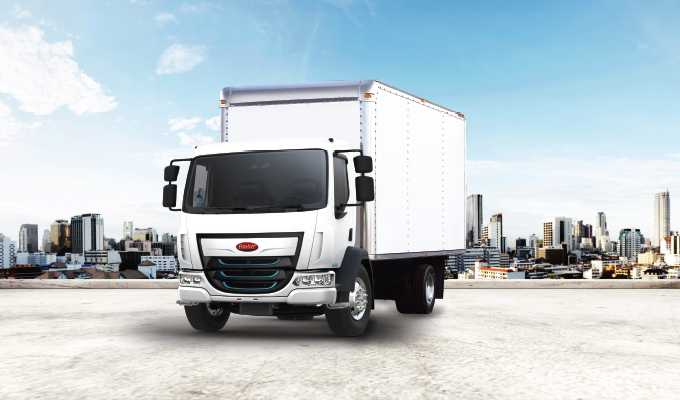The Peterbilt 220EV is designed for pickup and delivery, food and beverage, and regional haul applications. The goal in its design was to maximize driver comfort and productivity. And with it being an all-electric vehicle with a range of 200 miles, the Peterbilt 220EV can meet all your local needs in the cleanest way possible.
POWER & CHARGE
The zero-emission, all-electric 220EV features an e-motor, an onboard charger, and two battery packs. It gets up to 469 hp with battery capacities between 141 and 282 kWh.
In the place of what would be a large engine in a diesel-powered truck is the Peterbilt 220EV’s power electronic cradle. The power electronic cradle houses the vehicle software, cab heater and air conditioner unit, onboard charger, and battery disconnect controls. Its location offers an easily accessible service point to maximize uptime.And best of all, its total recharge time is only 1 to 2 hours when using a DC fast-charging system.
The 220EV is available in a Class 6 with a GVWR of 26,000 lbs and a Class 7 with a GVWR of 33,000 lbs. To further suit customers’ needs, Peterbilt gave the 220EV three different wheelbases: 206 inches, 218 inches, and 274 inches. The truck also has three different body length options: 24 ft, 26 ft, and 30 ft.
HOW IT WORKS
If you’re confused about how these electric vehicles can work without a conventional engine and transmission, let’s break it down.
In the Peterbilt 220EV, an inverter converts battery energy into power for the electric motor. Then the direct-drive motor powers the drive shaft. This eliminates the need for a transmission. Finally—and a must-have feature in electric vehicles in a “stop-and-go” application—is regenerative braking. This allows the truck to capture energy from braking and convert it into energy that can propel the vehicle forward.
Electric vehicles have their benefits. The obvious benefit is zero emissions, but the benefit that is less obvious is found in the vehicle’s maintenance frequency.
EASILY MAINTAINED
The Alternative Fuels Data Center states that electric vehicles typically require less maintenance than a vehicle with an internal combustion engine. This is due to the fact that the motor, battery, and associated electronics require little to no regular maintenance. There are also fewer fluids to maintain, such as engine oil. Then, because of regenerative braking, the Alternative Fuels Data Center found that brake wear is significantly reduced in electric vehicles. And finally, an electric vehicle simply has far fewer moving parts relative to a vehicle that runs on an internal combustion engine.
Due to these reasons, many EV owners have reported fewer trips to the service bay. However, when the truck does need service, Peterbilt designed it for an ease of serviceability to decrease downtime as much as possible.
CABIN FEATURES
Designed with the hardworking driver in mind, the Peterbilt 220EV offers enhanced driver visibility, great maneuverability with a tight turning radius, and a spacious interior with a cab width of 95 inches and a cabin height of 104 inches. The driver’s seat features air suspension with a two-person bench seat as a standard feature or an optional single-person air ride passenger seat. The truck also has standard cruise control and power windows as well as power and heated mirrors.
Additional features available include: speakers and wiring for customer-installed radio, wiring for customer-installed backup alarm, backup alarm, rear mud flap hanger and shields, Reyco rear shock absorbers, Reyco rear axle stabilizer bar, and orange or red seat belts.
And of course, the fact that the Peterbilt 220EV is an electric vehicle makes it a quieter machine to operate. This decreases driver fatigue and also increases the driver’s comfort.
COST COMPARISON
For those interested in purchasing a Peterbilt EV (the company has three in its lineup), Peterbilt’s website offers an Operating Costs Calculator (OCC). The OCC helps prospective EV owners compare the power consumption and fuel costs between a diesel-powered vehicle and an electric vehicle. Site visitors can input the cost of electricity, diesel fuel, the vehicle, and more to calculate which option makes the most sense for their fleet.
Local and federal incentive programs are also listed on the site. Some include up to 50% of new vehicle and charger cost, $185,000 of new vehicle cost, rebates of $150,000, up to 100% of the incremental cost compared to diesel, and more.
When it’s time to make a change to a new vehicle, opt for one that gets the job done as efficiently (and as clean) as possible.
FOR MORE INFORMATION
Find out more about the Peterbilt 220EV, incentive programs, and compare costs, visit www.peterbilt.com.




